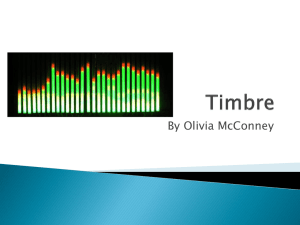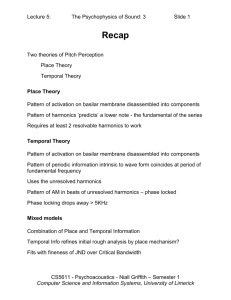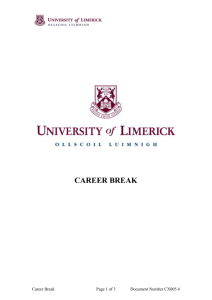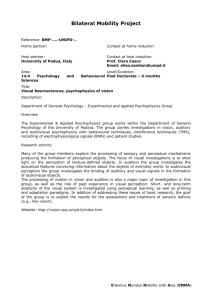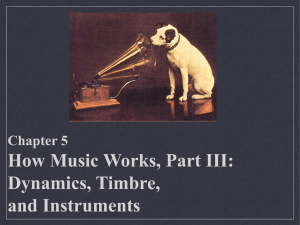Timbre - CSIS - University of Limerick
advertisement
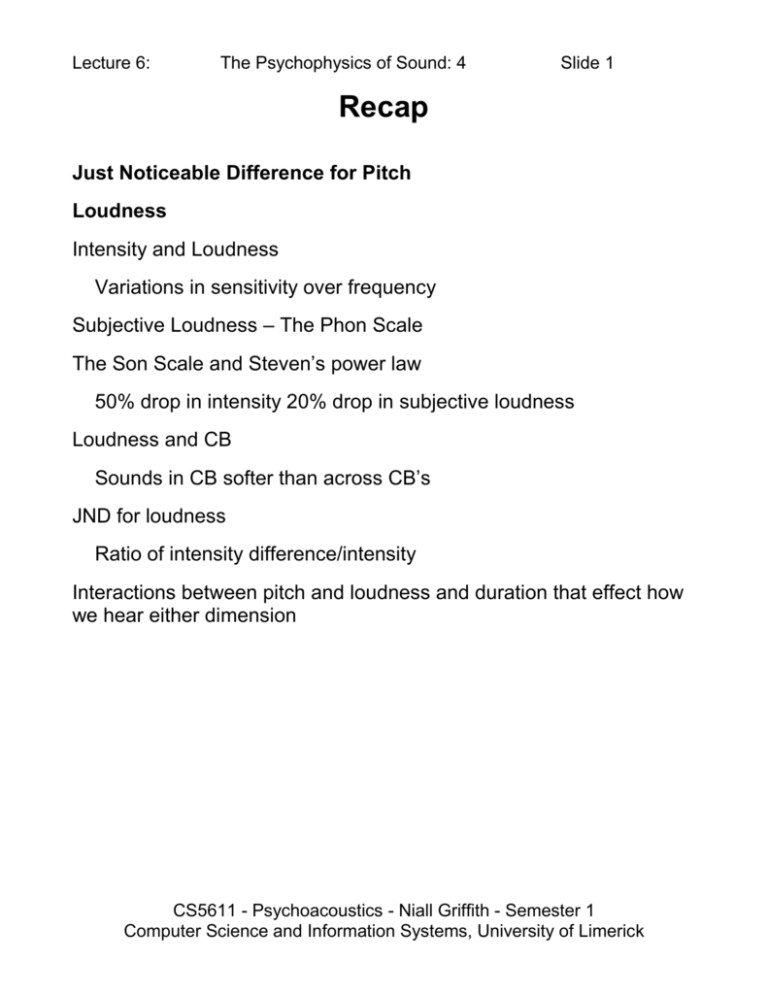
Lecture 6:
The Psychophysics of Sound: 4
Slide 1
Recap
Just Noticeable Difference for Pitch
Loudness
Intensity and Loudness
Variations in sensitivity over frequency
Subjective Loudness – The Phon Scale
The Son Scale and Steven’s power law
50% drop in intensity 20% drop in subjective loudness
Loudness and CB
Sounds in CB softer than across CB’s
JND for loudness
Ratio of intensity difference/intensity
Interactions between pitch and loudness and duration that effect how
we hear either dimension
CS5611 - Psychoacoustics - Niall Griffith - Semester 1
Computer Science and Information Systems, University of Limerick
Lecture 6:
The Psychophysics of Sound: 4
Slide 2
Timbre
Timbre
H&A
5.1, 5.3,
Timbre – Contribution of spectral components
Timbre – Critical Bandwidth
Timbre – Effect of envelope
Timbre – Judgements
Timbre – Frequency and Intensity
The Shepard Tone Illusion
Sound Localisation
H&A
5.5.4
H&A
2.4
Interaural Intensity Difference (IID)
Interaural Time Difference (ITD)
CS5611 - Psychoacoustics - Niall Griffith - Semester 1
Computer Science and Information Systems, University of Limerick
Lecture 6:
The Psychophysics of Sound: 4
Slide 3
Timbre
Timbre is the 3rd. major property of sound – it is not a dimension
Timbre is what distinguishes sounds that have the same pitch and the
same loudness. When two sounds have the same pitch and same
loudness but sound different this is due to a difference in timbre.
A complex characteristic constructed from
Frequency and Intensity of components over time
It is described in terms of the contributions of spectral components of
different energies and frequencies.
Timbre is the tonal quality of sound - lots of metaphors, sharp, liquid,
thick, dull, metallic etc.
Properties that can vary but may not effect Loudness and Pitch are:
Spectral Power distribution
Temporal Envelope - as shown by an oscilloscope
Rate and depth of amplitude modulation.
Inharmonicity of partials
There seem to be three orthogonal subjective or metaphorical
dimensions that people use to organise timbre
Dull Sharp
Compact Diffuse
Colourful Colourless
CS5611 - Psychoacoustics - Niall Griffith - Semester 1
Computer Science and Information Systems, University of Limerick
Lecture 6:
The Psychophysics of Sound: 4
Slide 4
Timbre - Spectral Components
Timbre of a complex tone is
affected by the presence or
absence of overtones or
harmonics - i.e. the balance of
spectral components.
Some example steady state
spectra of different instruments
The timbre depends on all of these components. This can be heard if
the components are added one after another to a sound.
Example – (JASA CD, Example 28, Track 53) - two instrumental
sounds built up in 8 steps by adding ascending harmonics.
What are the two sounds?
At what point does the sound become unambiguous?
CS5611 - Psychoacoustics - Niall Griffith - Semester 1
Computer Science and Information Systems, University of Limerick
Lecture 6:
The Psychophysics of Sound: 4
Slide 5
Timbre and Critical Bandwidth
A complex sound comprises a set of
resolvable (< 5th - 7th)
un-resolvable (> 5th - 7th). Harmonics.
Families of sound are distinguished by the spread of energy over
these two sets
Bright sounds
most energy in un-resolvable harmonics
o organ, saxophone, trumpet, violin, voice
Round sounds
most energy in resolvable harmonics
o wind (clarinet, oboe, flute, trombone, French horn, tuba)
For example compare the spectra
for the violin and flute.
But, also at the oboe which has
some characteristics of both?
Instruments with 7th harmonic are
described as reedy - e.g. clarinet this has only odd harmonics
Percussion has an inharmonic
series of partials – also important for piano timbre – gives warmth
Some have even fewer harmonics - that is even some of the
resolvable harmonics are absent
CS5611 - Psychoacoustics - Niall Griffith - Semester 1
Computer Science and Information Systems, University of Limerick
Lecture 6:
The Psychophysics of Sound: 4
Slide 6
Timbre - Effect of envelope
Sounds are not static – they evolve over their duration.
A sound’s history is called its Temporal Envelope.
The amplitude of a sound’s spectral components varies over time
A Temporal Envelope comprises three/four stages that are important
for the identification of Timbre
Attack
(Onset)
Decline
Steady State
(Sustain)
Release
(Offset)
Attack
Decline
Steady State
Release
CS5611 - Psychoacoustics - Niall Griffith - Semester 1
Computer Science and Information Systems, University of Limerick
Lecture 6:
The Psychophysics of Sound: 4
Slide 7
Envelopes of Components
The overall envelope is
comprised by
contributions by
components that
themselves have
envelopes.
The following picture
shows the changes in
amplitude of the
harmonics of two
instruments
(A) Trumpet
(B) Violin
The times of Onset and
Offset and the amplitude of the harmonics varies
Onset + Offset seem to dominate steady state when comparing
isolated sources
If Onset + Offset are removed from a sound then people find it more
difficult to identify the sound accurately
Also, synthesised sounds without the correct Onset and Offset are
unconvincing
There is also AM and FM for the components Shimmer and Jitter
CS5611 - Psychoacoustics - Niall Griffith - Semester 1
Computer Science and Information Systems, University of Limerick
Lecture 6:
The Psychophysics of Sound: 4
Slide 8
Judgements of Timbre
Judging Timbre is highly subjective.
Grey (Grey 1977) – ran a series of experiments to measure what
changes in sound contribute to perceived shifts in timbre.
Pairs of equal pitch, loudness, and duration synthesised sounds.
Other parameters of sound were varied.
Grey identified 3 principal dimensions that organised timbre space
Spectral energy distribution - amount of energy in high
frequency components
Synchronicity of attack of upper harmonics - from tight to
loose - synchronised to linear ordered
Amount of High Frequency energy in attack
Grey’s timbre space looks
like this in 3D.
Key:
FL= Flute, O=Oboe,
EH=English Horn,
BN=Bassoon, C=Clarinet,
X=Saxophones,
TP=Trumpet, FH=French
Horn, TM=trombone,
S=Cello
Greys sounds were
synthetic – fairly crude –
but results are accepted
CS5611 - Psychoacoustics - Niall Griffith - Semester 1
Computer Science and Information Systems, University of Limerick
Lecture 6:
The Psychophysics of Sound: 4
Slide 9
Timbre –the effect of envelope
This can be heard if a sound - say a piano - is played backwards
A piano has quite a hard attack – a number of components rise fairly
quickly – followed by a gradual tail off.
If the sound of a piano is reversed the sound has an extended onset
and then a abrupt offset – i.e. Like this visual reversal......
Example, (JASA CD, Example 29, Tracks 54-56) - a Bach choral
played forwards and backwards
Choral played forwards.
Choral played backwards and recorded
Backwards recording played backwards – that is the piece is played
forwards but with each note played reversed
The result is a sound is like a harmonium – very gradual onset, the
sound is very soft, swells and then drops off suddenly.
CS5611 - Psychoacoustics - Niall Griffith - Semester 1
Computer Science and Information Systems, University of Limerick
Lecture 6:
The Psychophysics of Sound: 4
Slide 10
Timbre – Frequency and Intensity
Pitches at different frequencies played by the same instrument have
different spectral balances
The relationship between energy in different harmonics and perceived
timbre means that timbre is dependent on pitch
e.g. the piano
Low tones have more energy in the higher harmonics
Higher tones have relatively more energy in the lower harmonics
and fundamental.
This is a problem for electronic musical instrument makers - sample
based patches - need a sample for every pitch on the keyboard and it
is also influenced by loudness as different harmonics die in the sound
at different rates at different sound levels
Example – (JASA CD, Example 30, Track 57 – Change in Timbre
with transposition)
An additional effect of the evolution of sounds in the Temporal
Envelope is that as the energy of different components changes so
the subjective perception of loudness can change, even if the overall
energy of the sound is approximately constant – i.e. within the JND.
This is caused by energy increasing in the middle frequencies –
where less energy is needed than at higher and lower frequencies.
This can be apparent with instruments like the Japanese Shakuhachi.
CS5611 - Psychoacoustics - Niall Griffith - Semester 1
Computer Science and Information Systems, University of Limerick
Lecture 6:
The Psychophysics of Sound: 4
Slide 11
A Timbre based Illusion - Shepard Tones
In general we assume there is little interaction between pitch
perception and timbre.
In general it doesn’t seem to matter about the distribution of spectral
components - we still hear a particular pitch irrespective of whether it
is played by a bassoon or a violin.
This separation of pitch and timbre is not completely rigid though –
and it doesn’t follow that there is no interaction between timbre and
aspects of pitch such as dissonance or consonance (Bregman,
1990)– although there has been very little work done on the
relationship between the two. (Dissonance and Consonance have
been studied with pure tones or relatively simple combinations)
However there is an auditory illusion in which the pattern of spectral
components and perceived pitch are related. This is the Shepard
Tones Illusion.
Shepard Tones create an auditory Illusion that is equivalent to the
visual illusion of Escher’s never ending stair or waterfall.
Example – (JASA CD,
Example 27, Track 52),
Shepard Tones, discrete
and continuous (Risset
slide)
CS5611 - Psychoacoustics - Niall Griffith - Semester 1
Computer Science and Information Systems, University of Limerick
Lecture 6:
The Psychophysics of Sound: 4
Slide 12
Shepard Tones
The Shepard Tone Illusion reflects an important aspect of pitch
organisation - Circularity in Pitch Judgement or Pitch Chroma. It is
interesting because Shepard Tones are constructed out of a particular
set of partials and this affects the way that we perceive their pitch.
The set of tones is constructed as follows:
There are 12 tones – each is equivalent to one of the 12
semitones in an octave.
Each tone is made out of 10 partials, each partial is separated by
an octave – this is not a natural overtone series of a complex
tone – in which the partials are separated by the fundamental
frequency. But this series does coincide with partials 1,2,4,8 etc
The Shepard Tone Series for a fundamental of 50 Hz is:
Frequency f
Hz
2*f
4*f
8*f
16*f 32*f
50 100 200 400 800
64*f
128*f
256*f
512*f
1,600 3,200 6,400 12,800 25,600
The partials for each
tone have an energy
distribution as shown.
The middle partials
have the highest
energy, while the high
and low partials have
lower energy.
CS5611 - Psychoacoustics - Niall Griffith - Semester 1
Computer Science and Information Systems, University of Limerick
Lecture 6:
The Psychophysics of Sound: 4
Slide 13
Shepard Tones - construction
Each of the (12) pitches in the scale is created by shifting the previous
pitch’s partials up by a semitone and changing its energy.
Each lower partial’s energy is increased and eac higher partial’s
energy is reduced.
When the scale is played we hear a
(apparently) continuously ascent that
never actually rises.
This is because the shift through the
octave involves each partial being
shifted in semitone steps - (each is
separated by an octave). The higher
partials decrease the lower partials
increase. So higher partials drop out
of hearing and lower partials come
up into hearing
After 12 steps the pattern of partials
is identical to the pattern at the start.
There are both discrete and
continuous pitch versions of this
illusion
Is there a difference between the visual and aural illusions? Is it
possible to hear the break in the aural illusion, i.e. the restart of the
ascent – but it is not possible to see the break the Escher staircase. Is
it possible to hear the break in the Risset glide?
CS5611 - Psychoacoustics - Niall Griffith - Semester 1
Computer Science and Information Systems, University of Limerick
Lecture 6:
The Psychophysics of Sound: 4
Slide 14
Measures of Timbre
When we think of timbre we think of the identity of the sound and in
music its quality.
These are related.
There are a variety of measures that attempt to capture the quality
of sounds. The question is how they relate to perceptual qualities.
Two that are particularly important are:
o Spectral Centroid: correlated to Brightness: measures the
frequency at which the energy of the sound is centred
o Harmonicity: plays a role in identification of sounds:
measures the degree to which partials are exact harmonics
Others included
o Irregularity: The variation in energy between partials
o Tristimulus: The colour of the sound
o Odd & Even: The ratio odd and even harmonics, e.g.
clarinet has only odd harmonics
o Roughness: The degree of perceptual dissonance
CS5611 - Psychoacoustics - Niall Griffith - Semester 1
Computer Science and Information Systems, University of Limerick
Lecture 6:
The Psychophysics of Sound: 4
Slide 15
Centroid and Harmonicity
i N
i N
a f a
i i
Centroid is defined as
i
i1
i1
It can be made pitch invariant by using the order of the partials.
i N
i N
a i a
i
i1
i
i1
Harmonicity can be defined in several ways. The most basic is
The ratio of energy in harmonics to total energy
i N
i N
a {harmonics} a
i
i
i1
i1
Irregularity can be defined in several ways. Jensen (1999)
N 1
an
n 2
an 1 an an 1
3
or
N
(a
n
n1
an 1)
N
2
a
2
n
n1
CS5611 - Psychoacoustics - Niall Griffith - Semester 1
Computer Science and Information Systems, University of Limerick
Lecture 6:
The Psychophysics of Sound: 4
Slide 16
Tristimulus & Odd & Even
The Tristimulus measures the balance of energy in the partials. It is
a measure of tone colour. It is related to Centroid
N
Tristimulus1
=
a1
a
i
i1
Tristimulus2
=
N
a
a2 a3 a4
i1
N
Tristimulus3
i
=
N
a a
i
i 5
i
i1
Odd and Even measure the balance between Odd and Even
Partials
Odd
N /2
=
a
N
a
2i 1
i
i 2
i1
N /2
Even
=
a
i1
N
2i
a
i
i1
CS5611 - Psychoacoustics - Niall Griffith - Semester 1
Computer Science and Information Systems, University of Limerick
Lecture 6:
The Psychophysics of Sound: 4
Slide 17
Sound Localisation
Perception of pitch, timbre and loudness are all to do with what is
sounding.
Our hearing is also concerned with localising a sound, i.e. where the
sound is coming from.
The direction that a sound is coming from is computed by using
information from the two ears. Just as with eyes the differences
between the signals received can be used to infer things about our
relationship to our environment.
Two properties differ between the ears – hence term - Interaural
The time at which sounds arrive.
Interaural Time Difference (ITD)
o The time difference between the of arrival of the sounds
Interaural Intensity Difference (IID)
o (Also called the Inter Amplitude Difference (IAD)
o The difference in intensity of the sounds that arrive.
These are broadly speaking related, Later == Softer
These are determined from how much the information reaching the
Olivary Body is correlated.
A sound gets to the nearer ear quicker
Less energy is absorbed getting to the nearer ear.
CS5611 - Psychoacoustics - Niall Griffith - Semester 1
Computer Science and Information Systems, University of Limerick
Lecture 6:
The Psychophysics of Sound: 4
Slide 18
Interaural Timing Difference - ITD
One ear can be up to 15 - 20 cm further away from a sound source.
The auditory system is thought to compute the angle relative to the
orientation of the head from the difference in time the sound takes to
arrive at the nearer or further ear.
ITD = r( + sin())/c
Where c is the speed of sound, r is the radius of the head and is the
angle (from the median) of arriving sound
An example
Sound travels at 770.4 mph (13,560 ips) (At 70F)
At an angle of 90 sound will have to travel approximately 8 - 11
inches further to get to the more distant eardrum –
8”
=
0.6 milliseconds
11”
=
0.8 milliseconds
The ear seems to be sensitive to differences as small as 10
microseconds (0.01 milliseconds)
Cells maximise firing when inputs from same and other side channels
are in phase, minimised when out of phase
CS5611 - Psychoacoustics - Niall Griffith - Semester 1
Computer Science and Information Systems, University of Limerick
Lecture 6:
The Psychophysics of Sound: 4
Slide 19
Interaural Timing Difference - ITD
time to nearer ear
=
t
time to further ear
=
time from ear to same-side Medial Olivary
=
time from ear to other-side Medial Olivary
= n+x
t+y
n
Medial Olivary cells fire most when the inputs from same & other side
ears are in phase. This happens when the time delay operates thus
This Side
Other Side
t + (n + x) = (t + y) + n
t+x=t+y
x=y
Depending on the angle between
the hearer and the sound the firings are more and less in phase
leading to higher or lower firing rates.
Other-side (contralateral) Medial Olivary cells fire most when the
airborne delay equals the nervous system delay of passing over to the
contralateral side. This increases as the angle increases.
The angle computed needs to have a sign to indicate the side the
sound is coming from
CS5611 - Psychoacoustics - Niall Griffith - Semester 1
Computer Science and Information Systems, University of Limerick
Lecture 6:
The Psychophysics of Sound: 4
Slide 20
Inter Intensity Difference (IID)
A sound has intensity when it is emitted form the source
As it travels it drops in intensity
This affected by both intensity (dB) and frequency
The principle causes of IID are thought to be
Diffraction of sound around the head,
Absorption by hair is thought to play some part
Higher sounds do not travel
round the head, as easily,
therefore there is a stronger
intensity shadow on the opposite
side for higher frequencies.
IID dominates ITD, particularly
for frequencies > 1.5 kHz
ITD is used at lower frequencies and IID takes over between 700 –
2.5 kHz
IID is dominant but in the middle region the two cues are traded-off.
Cues resolved by head movement – we turn to look at a sound
source, minimising the difference and confirming its direction – it also
places our visual attention on the source
CS5611 - Psychoacoustics - Niall Griffith - Semester 1
Computer Science and Information Systems, University of Limerick
Lecture 6:
The Psychophysics of Sound: 4
Slide 21
Front & Back Confusions in Localisation
Stevens and Newman (1936) found that for sounds below 2 KHz that
people frequently confuse whether a sound is in front or behind them.
This confusion declines above 2 KHz.
This is thought to be because ITD and IID are incomplete in that
cannot distinguish between whether a sound is in front or behind.
i.e. sounds share angles to the median line
A
B
It is thought the Pinna is used to resolve these ambiguities. (see
lecture 1)
Kuhn (1987) placed microphones in the ear canal and found that it
reduces (attenuates) the energy of higher frequency components.
Lower frequencies pass round the Pinna unaffected
Musicant & Butler (1984) found that peoples’ ability in locating sounds
is reduced if the pinna is occluded – i.e. the sound cannot enter it
directly.
The conclusion is that Pinna reduces the loudness of higher
frequency components to provide an additional loudness cue.
CS5611 - Psychoacoustics - Niall Griffith - Semester 1
Computer Science and Information Systems, University of Limerick
Lecture 6:
The Psychophysics of Sound: 4
Slide 22
Haas Effect
There is an associated aspect of localisation that arises from the fact
that we receive multiple cues from reflected as well as direct sound
This is the Haas Effect – or Precedence Effect
Signals arriving within 30 ms of primary sound are taken to be a part
of that sound and are ignored for direction
Reflection within 30 ms are fused – those after 30 ms are potentially
echoes - if loud enough, and are treated distinguished
This is part of a more general phenomenon that includes intensity
information.
We attribute a sound to the nearest – i.e. loudest (plausible) sound
source – we give the nearer/louder precedence
For example if there is an array of speakers all emitting the same
sound, we here at it as being in front – no matter where we stand
We can manipulate this effect by
changing the energy being output
by each speaker
If we stand equidistant between
speakers then we hear a ghost
speaker between them in front of
us
CS5611 - Psychoacoustics - Niall Griffith - Semester 1
Computer Science and Information Systems, University of Limerick

